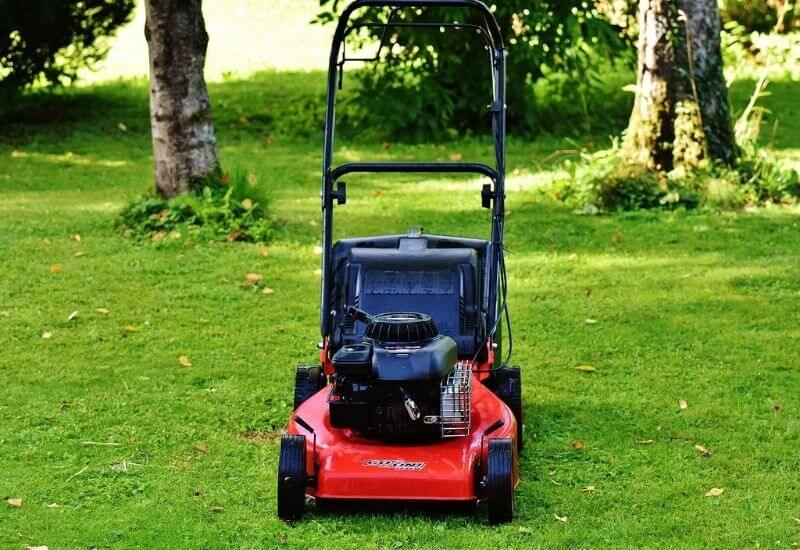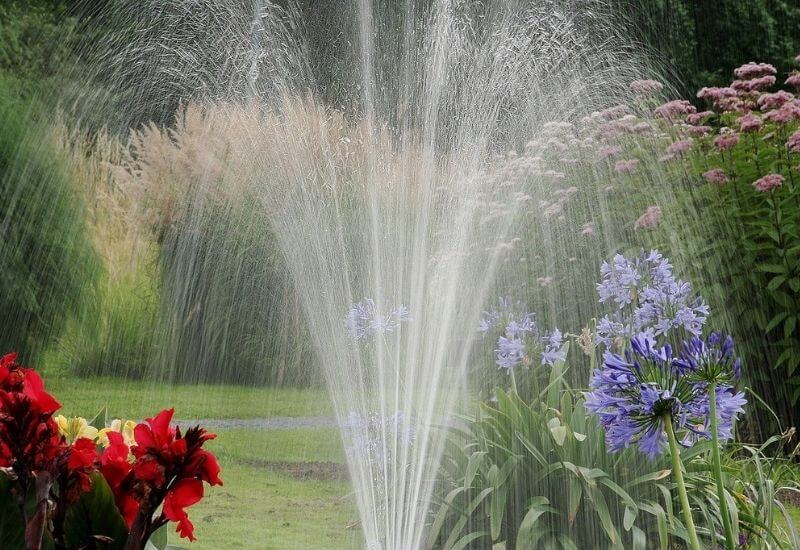Keeping your lawn green and healthy all year long takes time and effort. Failing to tend to it properly leaves you with an overgrown, dry, or dead turf.
Fortunately, maintaining your lawn in its best shape is easy with a few tips. Let’s look at the top 5 lawn maintenance tips that you should do to keep your turf in its best shape and also see some tools that you must keep around.
Table of Contents
5 Lawn Maintenance Tips You Shouldn’t Miss
The following 5 measures will ensure that your lawn stays healthy and as green as possible. Adhere to these to maintain your lawn all year round, and you’ll have fewer issues, such as diseases, to deal with.
Mow Your Lawn Regularly

Mowing your lawn as frequently as necessary is something you must do to keep it looking good. Otherwise, you’ll have an overgrown turf full of weeds, debris, and pests.
It’s important to keep your grass at the right height because besides giving your turf a uniform look, it also ensures proper utilization of resources.
The root system will be able to develop well, and you’ll have a denser turf. This will block out any weeds that may attempt to grow.
It also ensures that your grass takes up as many nutrients and water as it needs to stay green and healthy.
So, how often should you mow your grass?
It depends on the type of grass on your lawn. Some types require frequent cutting, for instance, Bermuda grass that you may have to mow twice per week.
Other types, such as Bahia grass, may take between a week or two before you need to mow them down.
Each type of grass also has a favorable height that it should be kept at for maximum growth and vibrancy. Therefore, ensure to research on how much your turf needs to be mowed and how often.
The Best Lawn Mower to Use
The right mower will make your work easier and keep your lawn in its best shape.
You can choose between traditional and robotic lawnmowers to get the work done.
Traditional mowers need manual operation, whereby you either ride or push them across your lawn.
These require you to take some time off your week to tend to your turf. If you’re not available for that, you may have to hire someone to do it for you.
This is not necessary when you use a robotic mower.
A robotic mower can work all day, all night, in your absence. You don’t need to be there to direct it across your lawn, and it’s even going to charge itself when needed.
Another major difference is that a robotic mower uses batteries for power, while traditional mowers need gas. The former is, therefore, more energy-efficient and eco-friendly.
While a traditional mower may have a lower upfront cost, a robotic mower may save you more money in the long run. This is because you won’t have to pay for either labor or fuel.
Finally, a robotic lawn mower is much quieter than a traditional one. Both your family and neighbors will definitely appreciate this.
Weed

There are few things that are as annoying as detecting weeds creeping through your grass. Common lawn weeds include dandelions, buttercups, creeping Charlie, and poison ivy.
If these take over your lawn, it’ll look untidy, and your grass will not be able to take up nutrients optimally.
Overgrown weeds will also block sunlight from reaching your turf, taking away its lush green color.
There are several ways through which you can remove invading weeds from your lawn, including:
- Trimming off their heads so that they cannot spread their seeds or cover your grass.
- Pulling them out by hand from the roots up.
- Using a herbicide to control the weed growth and kill them without harming your grass.
- Pouring sugar onto the weeds, causing them to wilt and die.
Besides competing with your grass for nutrients, weeds can also be a breeding ground for pests.
Therefore, I urge you to remove them from your lawn as soon as they appear.
Keep in mind that maintaining most lawn maintenance measures such as frequent mowing will also keep the weeds at bay for most of the time.
Water as Needed

You need to water your lawn frequently; otherwise, your grass will dry up and die.
But, this is not to mean that you should irrigate your turf each chance you get. Because while failing to water it will dry it up, over-doing it can also be detrimental.
Most lawns need about an inch of water weekly to stay in good health and shape.
If you water your lawn for about twenty minutes each time, you may need to do this thrice each week to get the one inch.
Of course, watering demands shift with the changing seasons. You will need to water your lawn more during the summer when it’s hot, and the rate of evaporation is high.
During cooler seasons, you may get away with doing it fewer times and for a shorter duration.
Avoid over-watering your grass because this can lead to a weak root system. It’ll also make it harder for your grass to survive through hot temperatures or when your water use is limited.
Another thing that you should keep in mind is the well-being of your lawn soil, as this will determine whether your watering efforts are successful or in vain.
The soil should have good drainage and aeration to prevent water-logging. The water should also not drain away too fast, leaving your root zone dry.
Morning hours are the best time to water your lawn because of the low rate of evaporation.
Fertilize
Mowing, weeding, and watering are lawn maintenance tips that can keep your turf green and in good health.
However, you may need a little help to keep your grass growing well with all the right nutrients.
That’s why you should consider using fertilizer on your lawn. Depending on the type of fertilizer that you use, you may need to reapply every four, six, or eight weeks.
Note that the best time to fertilize your grass is during its growing season. This usually means from the start of spring when the temperatures warm up, through fall.
Be careful not to use too much fertilizer on your lawn since this can be harmful to your grass.
Also, ensure to keep your fertilizer use in proportion to your watering frequency. The more water that your grass gets, the more fertilizer it’ll need to support the rate of growth.
When it comes to options, you may have to choose between organic and synthetic fertilizer. Both have their pros and cons, but if you’re looking for something that’s environment-friendly, then it’s best to go with natural fertilizers.
Compost and manure are good examples of organic fertilizers to use. However, beware that you’ll need to use more of them to get adequate nutrients compared to synthetic fertilizers.
Here are a few additional tips on how to get the most out of your lawn fertilizer:
- Water your lawn a few days before the application. That’ll make it easier for the soil to absorb the fertilizer and for the roots to take up nutrients.
- Only apply the fertilizer when the grass blades are dry; otherwise, you risk burning them.
- Some fertilizers require you to water your lawn right after application, while others need you to wait at least 24 hours before watering. Always check the user instructions to find out what’s the best action for the fertilizer that you’re using.
- Always use the right spreader and settings to apply your fertilizer. This makes the difference between whether you’ll apply enough, too little, or excess.
Edge
Edging is another lawn maintenance practice that’s necessary for a pristine look. This is whereby you make sure that your turf doesn’t grow beyond your lawn border or onto paths.
If you mow your lawn but fail to trim the edges, the overall net effect may be ruined.
Edge your lawn with a pair of long-handled shears right after mowing to keep it tidy.
Products to Make Lawn Maintenance Easier for You
Here are two products that you can use to make your lawn maintenance easier, both available on Amazon.
Black Decker 3-in-1 Lawn Mower, String Trimmer, and Edger
This versatile mower does the work of three lawn tools, saving you money and space.
It’s a compact tool that can be used as a mower, a trimmer, and an edger.
Its features include:
- An adjustable-height desk that allows you to either raise or lower the wheels for more comfort.
- A pivoting and adjustable handle that allows hassle-free use whether you’re mowing or edging your lawn.
- Two batteries that allow it to run for an extended time. This is also more affordable and environmental-friendly compared to oil or gas.
- Allows you to quickly insert or remove the edge or trimmer through a foot pedal release.
When you get this 3-in-1 mower, you’ll have taken care of three of the top lawn maintenance needs.
It’s easy to use, energy-efficient and takes a few moments to switch it from a mower to a trimmer to an edger. In short, everything you need for a tidy-looking lawn.
PBI/Gordon Speed Zone Lawn Weed Killer
A weed killer gets rid of invading vegetation on your lawn while leaving your grass in good health.
The Speed Zone Lawn Weed Killer from PBI/Gordon does just that.
It targets all the common lawn weeds, including the most stubborn ones. Creeping Charlie, dandelions, clover, and ground ivy are some of the weeds this product can remove from your lawn.
You can use it if you grow Bermuda grass, Kentucky bluegrass, fescues, perennial ryegrass, or Zoysia grass.
The Speed Zone Weed Killer:
- Provides results within hours of application, allowing you to reseed after 2 weeks.
- Is appropriate if you have a large lawn since it can cover between 14000-18000sq.ft.
- Does not pose any harm to the grass.
- Can be used safely during the cool seasons.
- Gets rid of the most troublesome weeds that other weed killers may be unable to kill.
If you’ve been having trouble with any kind of weed on your lawn, this product can turn things around for you in no time.
Conclusion
Practicing the top 5 lawn maintenance tips listed here ensures that your lawn remains healthy and looks good all the time.
Depending on the type of grass that you have on your lawn, do due research to find out what are the best mowing, watering, and fertilizing practices for it.
This is because not every turf is equal, and it should therefore not be treated without following specific guidelines.
With these tips and the right tools, you’re bound to have a tidy, eye-pleasing lawn all year round.



